
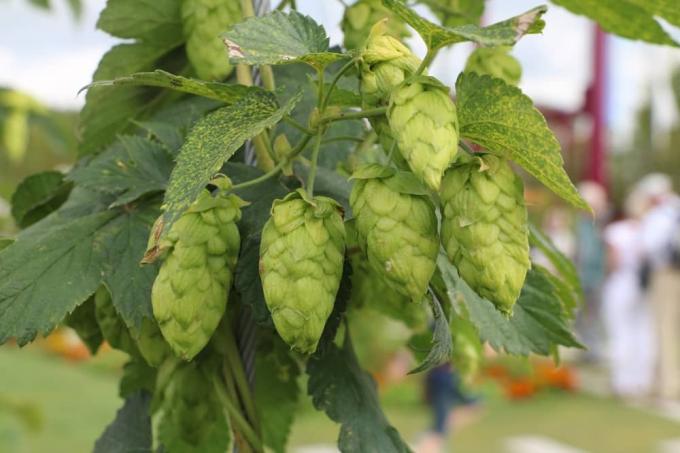
Table of contents
- Location
- climbing aid
- Floor
- Pour
- Fertilize
- hibernate
- Plant
- bucket
- cut
- multiply
- division
- shoots
- sowing
- diseases and pests
- Powdery mildew and downy mildew
- Aphids, Hop Aphids
- hop wilt
- sorts
- Neighbors
- harvest
- Conclusion
The Humulus lupulus belongs to the hemp family (Cannabaceae) and the pretty cones can also have a calming effect as an herbal infusion. For the garden it is above all a visual enrichment, it is often used as a privacy screen or shade. He wraps himself up on everything that comes his way. His hop cones are beautiful to look at, even if they aren't temptingly brightly colored. Even if the humulus almost completely disappears in winter, it returns every spring.
Location
If you want to plant hops as a privacy screen, you should note that most varieties are perennial, but retreat to the vine in winter. It offers attractive, dense privacy protection from June to September.
The hops are native here, robust and generally quite adaptable to their respective location. Nevertheless, he loves it sunny and warm. A southwest, southeast location would be ideal for him. The more you focus on your location preferences, the less you will have to deal with diseases and pests later, and the easier it will be to take care of them and bloom.
When choosing the location, you have to take into account the fact that it not only spreads rapidly above ground, but also underground in relation to the neighboring plants.
Another important location requirement is a climbing aid.
climbing aid
The climbing aid can be made of wire or rope. A trellis made of wood or iron can give the hops a nice shape. With every construction you should keep in mind that the hop plants are very vigorous, 7 to 9 meters high are not uncommon. The scaffolding must not be too small and must also be stable enough.
During growth it will always be necessary to give the hops a little help with their tendrils. The Humulus winds to the right, so when helping, always start clockwise so as not to confuse it. In fact, growth falters when he gets the wrong spin.
If hops are to green a facade or wall, they must be given climbing aids around which they can twine. In return, it leaves no traces or damage to the masonry, such as ivy or virginia creeper.
Tip:
Particularly decorative climbing aids are rose arches that are placed individually or in groups along a path.
Floor
Since hops grow very quickly, they also need nutrient-rich soil. The optimum pH is between 6.0 and 6.6. In addition, it prefers a deep, loose soil that tends to be moist. Both extremes, heavily compacted soils that tend to be extremely dry, are less suitable.
Pour

Hops also need a lot of water for their rapid growth. Regular watering is mandatory. With a layer of mulch you can ensure that the soil retains moisture a little better. If the summer is very dry, make sure that the soil does not dry out. The hops can survive, but growth this year suffers badly.
Fertilize
Above all, hops need sufficient nitrogen for their lush growth. Nitrogen-poor soil can be improved naturally with nettle manure. In the spring, well-ripened compost or animal manure is worked in around the plant. During the growth phase in summer, further doses of organic fertilizer can then be incorporated, preferably once a month, until mid-August. A vegetable fertilizer is well suited.
hibernate
In winter, the humulus retires on its own, that is, the upper parts wither away. But the rootstock is hardy and does not need special protection outdoors. New shoots will grow from it in April. Then it is high time to free the climbing aid from the dead remains from the previous year.
Plant
Autumn and spring planting is possible. The hops only really pick up speed when they are well rooted. In the first year you can't expect too much growth. Autumn planting may be a little more advantageous here.
The young hop plants are usually sold by the nurseries in small containers up to a meter high. However, hops can also be sown relatively easily in summer, especially the annual ornamental hop varieties.
Regardless of whether you plant or sow, a climbing aid should be attached at the same time. If it has to be embedded in the ground, do not destroy the young roots afterwards if it becomes necessary.
The plants or seedlings from seed are then planted in the spring. Two to three plants can share a climbing aid. Leave a distance of up to two meters between the climbing aids.
Immediately when planting, give the hop plants a good portion of mature compost, because it needs a lot of nutrients for its rapid growth. If you like it natural, you can always add compost or horn meal during the growth phase.
Tip:
When planting hops, bear in mind that they tend to spread very far and quickly underground. Therefore, a bucket culture is sometimes quite an advantage.
bucket
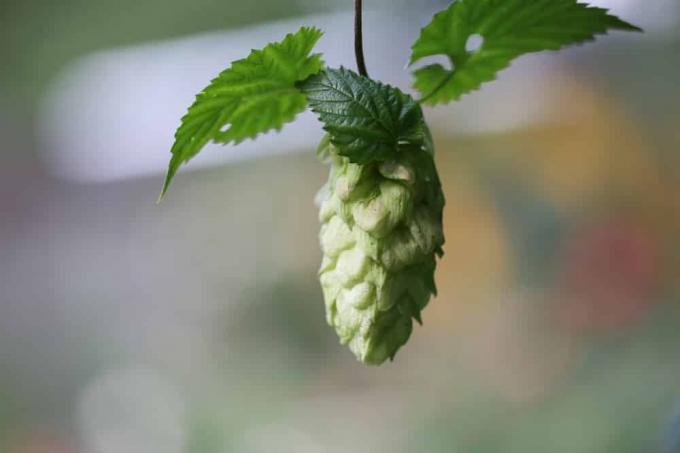
Hops can also be grown in planters, but only outside. Maybe a good idea for a privacy screen in summer, on the terrace or on the balcony. When growing in tubs, you have to make sure that the hops get enough nutrients for their rapid growth.
- Planters should be at least 18 cm in diameter
- Use good quality potting soil
- Use climbing aids of at least 1.50 meters at the same time
- Repot sparingly when the roots hardly leave any space for substrate
- Repot in spring
- regular fertilizer application with complete nutrient fertilizer once or twice a week
- Watering: no waterlogging and do not let dry out
- In the tub, hops need winter protection
- an insulating base and wrap the bucket with fleece or a straw mat, so it will survive the winter outside well
cut
Every year in April, new shoots emerge from the hardy hop stock. Depending on the purpose, you can decide for yourself whether you want to leave all the shoots or remove them except for a few shoots. If a high solitary plant is desired, only a few shoots are left standing.
In autumn, the humulus can be shortened to half a meter. The withered stems should be left as they are during the winter and only removed in the spring. Because this allows the nutrients to withdraw into the rootstock.
Otherwise, in the summer during the growing season, the hops are not pruned any further. Disturbing tendrils can be removed and you are welcome to help him with the tendrils (always nice and clockwise).
multiply
The most promising and common methods are division of the rootstock and propagation by shoots:
division
The division can be made in the fall or early in the spring. To do this, take the root ball out of the ground and carefully divide it without damaging the root system. Both parts are then reinserted in their desired location.
shoots
For propagation through shoots, cut approx. 10 cm long shoot ends. These can be placed directly in a pot with growing soil. Spray regularly, best cover with foil or a plastic bag, a lot of humidity is now desired. When the first shoots are visible, they have already formed roots and, depending on the season, can be planted in the ground.
sowing
Sowing hops is not that common. Mostly it is propagated vegetatively to be sure to keep the characteristics and especially the sex. In some hop-growing areas, sowing is even forbidden, as this leads to male, low-yield hops or susceptible plants could grow which would then adversely affect existing crops affect.
If you still want to try it (in regions without professional hop cultivation):
- March sowing date
- Cold germinator, the seed needs exposure to cold for some time
- if necessary, three weeks of refrigerator storage is sufficient
- Sow in potting soil
- Scatter the seeds, press lightly and cover with a thin layer of soil
- needs warm temperatures for germination
diseases and pests
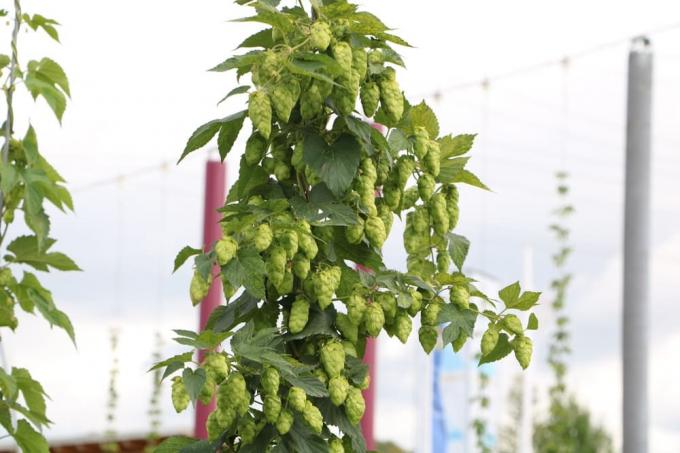
If you don't grow your hops extensively and as a crop, you don't have to worry too much about specific diseases and pests. The usual can happen when it's too wet or too dry:
Powdery mildew and downy mildew
Almost every climate has its type of powdery mildew. The real one occurs predominantly in hot dry summers. Downy mildew likes it damp and rainy. There are around 100 types of this fungal disease. The best advice for combating it is to cut off the affected parts of the plant as soon as possible and spray it regularly with nettle or horsetail decoction, especially in spring.
Aphids, Hop Aphids
Almost every plant genus has its preferred type of aphid. Bad weather or poor care calls them into action. The tried-and-tested motto here, too, is to recognize the infestation in good time, remove parts of the plant and spray with stinging nettle liquid
With the removal of the old shoots in the spring, many of their clutches are also caught. To be on the safe side, destroy the cut and do not put it in the compost.
hop wilt
This dreaded fungal infection mainly occurs with non-resistant hop varieties and with persistent waterlogging. The fungus clogs the plant's water veins, causing it to wilt and eventually die. There are no remedies against this disease and unfortunately the whole hop plant can only be disposed of.
Tip:
Insects such as soft bugs, cicadas, flea beetles, thrips and robbers also like the hops, but do not harm them any further.
sorts
From real hops (Humulus lupulus) There are many varieties available in nurseries. For the professional cultivation of hops alone, the specialist trade offers many types of cultivation that are unlikely to be that interesting for the private garden. Here are some attractive hop varieties for the garden:
Gold hop (Humulus lupulus 'Aureus')
It does not grow as vigorously as wild hops. The shapely leaves grow dense and light green in summer. In the trade you will only get male plants. This means that the gold hops do not form cones, but shine through their magnificent foliage. It prefers partially shaded locations.
Japanese ornamental hops (Humulus japonicus or Humulus scandens)
This ornamental hop is an annual and spreads by sowing. The Japanese ornamental hop was also primarily bred for its attractive foliage. However, the female plants produce light green fruits in September. The Japanese ornamental hop is well suited for semi-shady to shady locations.
Hop 'Golden Princess' (Humulus lupulus 'Golden Princess')
The 'Golden Princess' loves it sunny. But it grows rapidly and tall, up to 6 meters high. Its flowering begins very early in the year. The female plants then show magnificent, eye-catching hop cones distributed over the entire height.
Dwarf hop 'Gimli' (Humulus lupulus 'Gimli')
This dwarf hop is perfect for tub culture, although it can also reach a good three to four meters in height. It is particularly resistant to powdery mildew. From August, the female plant develops very large hop cones, but the leaves are slightly smaller.
Tip:
Only the female plants form the typical hop cones. Whether it is a female or male specimen can only be seen during the flowering period. Depending on the variety, you should ask the nursery in advance which gender the plant is.
Neighbors
The Humulus isn't exactly considerate as a neighbor. It is very expansive both above and below ground and crushes most of the neighboring plants. Therefore, perennial climbing plants that become woody and are not cut back to the stalk in autumn are less suitable for combining with hops.
But an attractive arrangement can be planted with annual climbing plants that are also strong, such as morning glory (Ipomoea) or the sweet pea (Lathyrus odoratus).
harvest
Only the female hop plants are suitable for harvest. Because only they form the fruits or cones after flowering, which contain the coveted lupulin. Harvesting hops for beer is quite a complex matter and is described in detail in the relevant specialist literature.
But maybe one or the other would like to harvest a few cones for a soothing tea in the evening. The best time for this is in August to September. To check whether the lupullin has already formed, you take a cone that is still closed and open it. It should then contain a yellow powder and smell aromatic. When the time comes, you can harvest the cones and prepare them for tea with hot water. Both fresh and dried hop cones can be used to prepare tea.
Conclusion
In any case, the hops are ideal for impatient gardeners who want to get green quickly. However, you have to tirelessly ensure sufficient nutrients and water during the growth phase. It is important to keep a close eye on the soil and the neighborhood over the years. The humulus also likes to spread surprisingly in less desirable places.
 garden editorial
garden editorial I write about everything that interests me in my garden.
Learn more about climbing plants
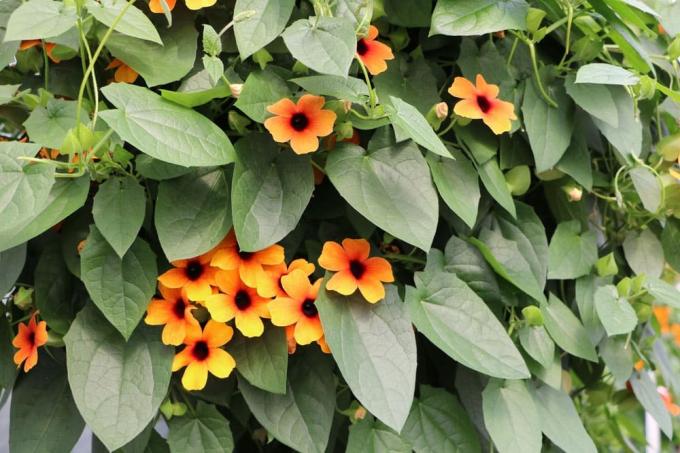
Is black-eyed Susan poisonous?
Black-eyed Susanne can delight all of our eyes with colorful flowers. But if small children or pets are around it, it is important that we also clarify whether it is possibly poisonous. The answer to that is clear and a little surprising!

Black-eyed Susanne, Thunbergia alata: Care from A – Z
Black-eyed Susanne is one of the most popular climbing plants. It is ideal for greening house walls, balconies, fences and pavilions. If you follow our care tips, you will enjoy the splendor of their flowers.
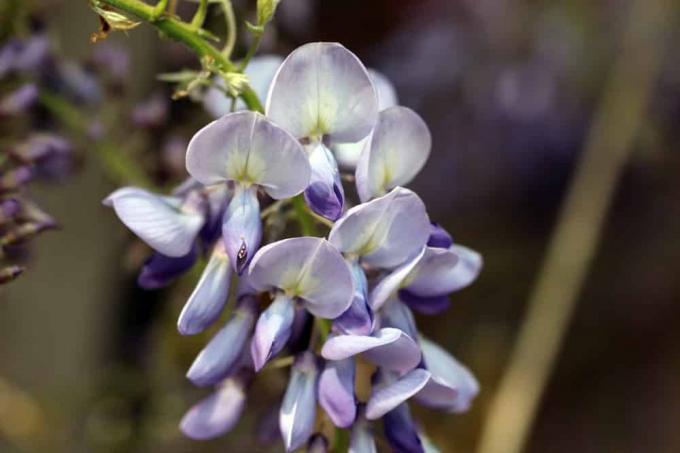
How fast does wisteria grow? | Information about growth
As its name suggests, the wisteria, as an intensive climber, enriches walls, trellis structures and other possibilities for spreading a magnificent, glowing blue sea of flowers. You can find out what you should consider when growing with us in a simple and understandable way.

How fast does Virginia creeper grow? | Information about growth
If you want a trellis or a house wall to be lushly greened, you will find a grateful partner in Virginia creeper. Over time, it can grow into large areas and, especially in autumn, enrich it with colorful foliage. Contact us for helpful information on growth.

Evergreen honeysuckle: care from A to Z
The evergreen honeysuckle is popular for greening walls or fences, because the creeper is green all year round and has beautiful delicate flowers. Although the honeysuckle is not very sensitive, it needs a minimum of care for it to develop well.

How fast does ivy grow? | Accelerate growth effectively
Ivy (Hedera helix) is a true climber that climbs up walls and house walls without any problems and can have a very decorative effect. Once it has taken root, it can literally overgrow large areas in a very short time. You can literally watch him grow.
